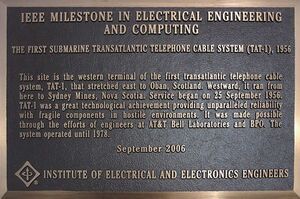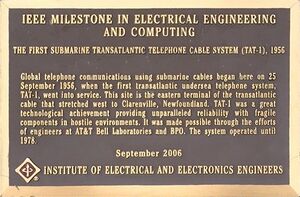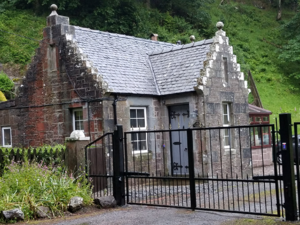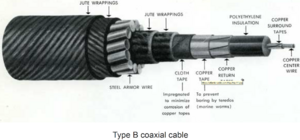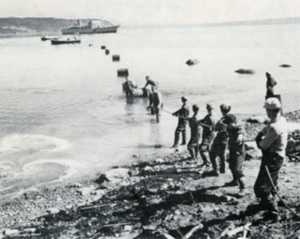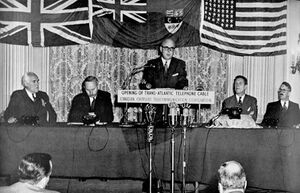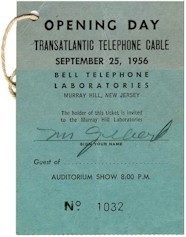Milestones:The First Submarine Transatlantic Telephone Cable System (TAT-1), 1956
- Date Dedicated
- 2006/09/24
- Dedication #
- 70
- Location
- Clarenville, Newfoundland, Canada
- Sydney Mines, Nova Scotia, Canada
- Oban, Scotland
- IEEE Regions
- 7, 8
- IEEE sections
- Newfoundland-Labrador, Canadian Atlantic, United Kingdom and Ireland
- Achievement date range
- 1956
The First Submarine Transatlantic Telephone Cable System (TAT-1), 1956
Oban, Scotland plaque
Global telephone communications using submarine cables began here on 25 September 1956, when the first transatlantic undersea telephone system, TAT-1, went into service. This site is the eastern terminal of the transatlantic cable that stretched west to Clarenville, Newfoundland. TAT-1 was a great technological achievement providing unparalleled reliability with fragile components in hostile environments. It was made possible through the efforts of engineers at AT&T Bell Laboratories and BPO. The system operated until 1978.
Clarenville, Newfoundland plaque
This site is the western terminal of the first transatlantic telephone cable system, TAT-1, that stretched east to Oban, Scotland. Westward, it ran from here to Sydney Mines, Nova Scotia. Service began on 25 September 1956. TAT-1 was a great technological achievement providing unparalleled reliability with fragile components in hostile environments. It was made possible through the efforts of engineers at AT&T Bell Laboratories and BPO. The system operated until 1978.
Sydney Mines, Nova Scotia plaque
Global telephone communications began on 25 September 1956, when the first transatlantic telephone system, TAT-1 went into service. TAT-1 was a great technological achievement, made possible through the efforts of engineers from AT&T Bell Laboratories and BPO. It provided unparalleled reliability with fragile components in hostile environments. Engineers of the BPO, using their experience in subsea communications, developed the specific portion of TAT-1 between Clarenville, Newfoundland and Sydney Mines, Nova Scotia in this laboratory.
The plaques can be viewed in two of the three locations: at 52 Cormack Dr., Clarenville, Newfoundland, Canada; at the Cape Breton Fossil Centre in Sydney Mines on Cape Breton Island, Canada. The plaque at Gallanach Bay, about 4km south of Oban, Scotland is currently underwater and not in a safe location. However, here is a link to an article about visiting the site site at Gallanach Bay, including the cable housing where the cable comes ashore. A section of the cable and other artifacts and information about the project are in the Oban War and Peace Museum at the corner of the Corran Esplanade and John St., Oban.
The first transatlantic telephone cable, TAT-1, inaugurated the modern era of global communications. Many of the basic concepts and processes developed for achieving highly reliable submarine infrastructure have not changed significantly from those used in TAT-1. Before TAT-1, voice was carried across the Atlantic on unreliable and expensive radio channels. Text messaging was carried on submarine telegraph cables (the technology of the previous 90 years) which were reliable, but slow and expensive.
Cooperation between North America and the United Kingdom to build an electrical bridge across the Atlantic had gone back over a century. After a period of failure and learning, the Great Eastern, the world’s largest ship, laid in 1866 the first permanent transatlantic link under the leadership of Cyrus Field, and telegraph communication began. However, the communication capacity of the first transatlantic cable was very limited while the demand for rapid communication continued to increased.
Telegraph systems developed steadily over the years. Advances in materials and techniques, such as inductive loading, led to gradual increases in performance to the point that, in 1919 a study of deep-water submarine telephones began. In 1928 this work culminated in a proposal for a repeaterless cable bearing a single voice channel. Two considerations, however, killed the project: radio circuits were continuously improving, and the cost estimate was $15 million, a prohibitive price tag after the economic collapse that began in 1929.
A commercial radiotelegraph service, which began in 1908, had greatly contributed to transatlantic communication. Transatlantic long-wave and short-wave services had been established in 1927 and 1928, respectively. The first commercial voice link across the Atlantic, which was launched in 1927 with a single radio telephone circuit, shed new light on the desirability of a transatlantic telephone cable. While radio circuits provided a voice service, the vagaries of sunspot and seasonal and daily variations were never overcome entirely. Moreover, radio did not guarantee its users privacy and security. Recognition of the technical limitations of radio for transatlantic telephony led to studies of the feasibility of a North Atlantic submarine telephone cable.
In the mid-1930’s electronic technology had advanced to the point where a submarine cable system with repeaters, electrical devices that would boost voice signals after they had reached the fading point along a circuit, became feasible. Since the repeaters had to have sufficiently long lives to operate with small likelihood of failure over a period of time, they were subject to rigid reliability requirements. Most fragile, however, were the vacuum tubes, which were the only means of amplification. Development of these tubes was begun in 1933, and they were continually tested for a period of eighteen years.
The North American side utilized the flexible repeater technology in the 1950 Havana-Key West cable, which adopted an earlier version of the TAT-1 repeater. British Post Office had developed a single repeater system and used it for shallow-water links in the 1940’s.
In 1953 the agreement for the first transatlantic telephone cable was signed. TAT-1 was a joint effort of AT&T Bell Laboratories, the British Post Office Engineering Department, and the Canadian Overseas Telecommunication Corporation. The design of the TAT-1 repeater provided a unique solution to the historic challenge of placing a telephone cable two and a half miles beneath the surface of the North Atlantic. The repeater was flexible thus allowing it to be wound over a cable standard drum. It was eight feet long and had a diameter of 2.875 inches tapering down to the cable width of 1.625 inches over twenty feet.
The main Atlantic link, designed by the Bell System, called for two cables (one in each direction of transmission), which embodied one-way flexible repeaters at 37-mile intervals. H.M.T.S. Monarch, then the world’s largest cable ship, laid the two cables in the summers of 1955 and 1956, respectively. The links were from Clarenville, Newfoundland to Oban, Scotland. Each cable had fifty-one repeaters in a cable stretching over approximately 1950 nautical miles. The repeater provided 65 dB of gain and 144 kHz bandwidth around 164 kHz. Amplification in each repeater was made possible by means of three vacuum tubes, whose design, testing and manufacture set new standards of reliability. The vacuum tubes of the original TAT-1 never failed in twenty-two years of continuous service from 1956 to 1978. TAT-1 also included an overland portion and an underwater link. The Canadian provided an overland line-of-sight radio system from Nova Scotia to Montreal and to a point in Maine where the Bell System took over. Under the shallow waters of the Cabot Straits, British-pioneered two-way rigid repeaters allowed transmission from Newfoundland to the mainland through Sydney Mines, Nova Scotia over a single cable. TAT-1 initial service provided twenty-nine telephone circuits between London and New York, six circuits between London and Montreal and a single circuit split among the three destinations for telegraph and other narrow band applications.
Over the last fifty years since TAT-1 went into service, the capacity of telephone cables has grown explosively from initial thirty-six voice-band channels to modern broadband optical fiber systems. Today, single cables can support eight fiber pairs and carry in excess of eight terabits of capacity across the Atlantic and the Pacific Oceans, which is approximately four million times the number of voice circuits carried on TAT-1.
With communications traffic traveling at the speed of light on undersea cable, optical or electrical, the time difference encountered between end points across the ocean or across a city does not disturb communications being barely noticable hence, there is little difference between a voice call to another continent and one within one’s own city. The transmission capabilities of undersea optical fiber are crucial for linking computers of different continents. Whether surfing the internet, making a reservation or calling a friend in another country on another continent, all these services are made possible due to the unique technologies deployed in modern global submarine cable systems, whose progenitor was TAT-1.
References
- Jeremiah F. Hayes, “Paths Beneath the Seas: Transatlantic Telephone Cable Systems,” IEEE Canadian Review, Spring 2006.
- Jeremiah F. Hayes, Reminiscences of TAT-1
- Homer Bigart, “First Call Made by Phone Cable to Europe,” The New York Times, Sep 26, 1956.
- “The First Transatlantic Telephone Cable (TAT 1)”
- “Scanning Our Past from London: Voices under the Atlantic.” Proceedings of the IEEE, Vol. 90, No. 6, June 2002, 1083-1085.
- Atlantic-Cable.com story: TAT-1 Opening Ceremony
Map
Map
